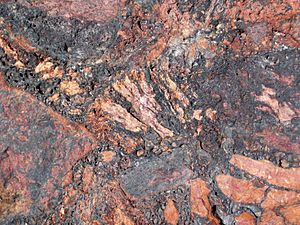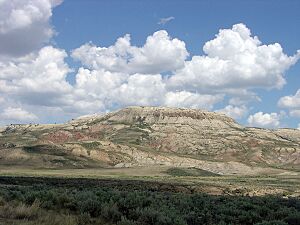Wasatch Formation facts for kids
Quick facts for kids Wasatch FormationStratigraphic range: Early Eocene (Clarkforkian-Bridgerian) (typically Wasatchian) ~56.8–46.2Ma |
|
|---|---|

Clinker-bed breccia from the Wasatch Formation (Wyoming)
|
|
| Type | Formation |
| Sub-units | See text |
| Underlies | Green River & Fowkes Formations, Santa Fe Group |
| Overlies | Fort Union, Williams Fork, Torrejon & Evanston Formations |
| Thickness | Variable, up to 1,500 m (4,900 ft) |
| Lithology | |
| Primary | Mudstone, shale, siltstone, sandstone |
| Other | Claystone, lignite |
| Location | |
| Coordinates | 41°12′N 108°48′W / 41.2°N 108.8°W |
| Approximate paleocoordinates | 46°00′N 92°36′W / 46.0°N 92.6°W |
| Region | |
| Country | |
| Extent | Powder River, Green River, Wind River, Bighorn, Piceance & Uinta Basins |
| Type section | |
| Named for | Wasatch Range |
| Named by | Hayden |
| Location | Echo Canyon, Summit County & Weber Canyon, Ogden, Utah |
| Year defined | 1873 |
| Coordinates | 40°53′N 110°58′W / 40.88°N 110.97°W (Echo Canyon) 41°08′09″N 111°54′14″W / 41.13583°N 111.90389°W (Weber Canyon) |
| Region | Utah |
The Wasatch Formation is a huge rock layer found in many parts of the western United States. It stretches across Idaho, Montana, Wyoming, Utah, and western Colorado. This formation is super important because it holds many fossils from the Early Eocene time period, which was about 56.8 to 46.2 million years ago.
Scientists use the Wasatch Formation to help define a specific time in Earth's history called the Wasatchian age. During this period, many different kinds of animals lived, including early primates, hoofed animals like artiodactyls and perissodactyls, rodents, and carnivora (meat-eaters). We also find fossils of birds, reptiles, fish, and even tiny invertebrates. Besides animal remains, the formation also contains plant fossils and trace fossils, which are things like ancient footprints or burrows.
The Wasatch Formation was first named in 1873 by Ferdinand Vandeveer Hayden. It formed in areas where rivers flowed, floods happened, and lakes existed. The rocks are made of sandstones, siltstones, mudstones, and shales. It also has layers of coal or lignite, which show that parts of these ancient floodplains were wet and swampy.
Today, the Wasatch Formation is important for energy. It contains "tight gas," a type of natural gas that is hard to get out of the rock. People also mine coal from it in Wyoming. At the Fossil Butte National Monument, you can see the Wasatch Formation rocks right below the famous Green River Formation.
Contents
What is the Wasatch Formation?
How it was named
The Wasatch Formation was first called the Wasatch Group by Ferdinand Vandeveer Hayden in 1873. He studied rocks in the Echo and Weber Canyons, which are near the Wasatch Mountains. The name "Wasatch" comes from the Ute people's language and means "mountain pass." Another idea is that it comes from a Shoshone leader named wasattsi, meaning "blue heron."
Where to see the rocks
You can see the Wasatch Formation at the bottom of Fossil Butte National Monument. The rocks here are bright red, purple, yellow, and gray. They gently slope up from the valley. Above them are the lighter-colored rocks of the Green River Formation. The Wasatch Formation can be very thick, up to about 4,900 feet (1,500 meters) in some places. It's also visible in Desolation Canyon and Gray Canyon in Utah, and at Flaming Gorge National Recreation Area.
Where the formation is found
The Wasatch Formation is found in six states: Montana, Idaho, Utah, Wyoming, Colorado, and New Mexico. It's part of several large geological areas, including the Wasatch Range, Uinta Mountains, Green River, Piceance, Powder River, and Uinta Basins. In Montana, the Wasatch Formation sits on top of the Fort Union Formation.
Layers of the Wasatch Formation
The Wasatch Formation is made of many smaller layers, or "members," that have their own names. These layers can be different in different places. Here are some of the named members:
| Member | States | Rock Types |
|---|---|---|
| Alkali Creek Tongue | Wyoming | Mudstones and sandstones |
| Atwell Gulch | Colorado | Sandstones and mudstones |
| Cathedral Bluffs Tongue | Colorado, Wyoming | Mudstones and sandstones |
| Hiawatha | Colorado, Utah, Wyoming | Sandstones and mudstones |
| Kingsbury Conglomerate | Wyoming | Conglomerates (rocks with pebbles) |
| Knight | Utah, Wyoming | Sandstones and mudstones |
| Molina | Colorado | Sandstones |
| Niland Tongue | Colorado, Wyoming | Sandstones and mudstones |
| Shire | Colorado | Sandstones and mudstones |
What the rocks are made of
In Wyoming, the Wasatch Formation mostly has colorful mudstones. It also has layers of siltstones, sandstones, and conglomerates. These rocks formed on a wide plain between mountains. In Colorado, the formation has purple, red, and gray claystones and shales. It also has lenses of sandstones that came from rivers and lakes.
The Molina Member is a part of the formation with more sand. It formed when changes in the Earth's crust or climate caused a lot of sand to be washed into the basin. This sandy layer is important for finding natural gas.
Where the rocks came from
Scientists study tiny mineral grains called zircons in the Wasatch Formation. These zircons tell us where the sand and mud came from. Most of the grains are very old, about 2.9 billion years old. This matches the age of rocks in the core of the Bighorn Mountains. This means the Bighorn Mountains were eroding and shedding sediment into the area when the Wasatch Formation was forming. The presence of the Kingsbury Conglomerate at the bottom of the formation shows that the Earth's crust was very active nearby.
Why the Wasatch Formation is important for fossils
The Wasatch Formation is key to understanding the Wasatchian age, which lasted from about 55.8 to 50.3 million years ago. This time period is special because it marks the first appearance of many new types of mammals, including early primates and hoofed animals. The formation was laid down during a time when Earth was very warm, known as the Paleocene-Eocene Thermal Maximum (PETM). The average temperature was around 77°F (25°C).
At Fossil Butte National Monument, the Wasatch Formation has preserved trace fossils made by arthropods (like insects or crabs). These include burrows and tracks. These traces show how animals lived in different environments, like floodplains and river channels.
Animals found in the Wasatch Formation
Many amazing fossils have been found here!
Mammals
- Primates
- Absarokius abbotti
- Cantius frugivorus
- Microsyops angustidens
- Notharctus robinsoni
- Plesiadapis dubius
- Tetonius matthewi
- Many others!
- Hoofed Animals (Artiodactyls and Perissodactyls)
- Diacodexis secans (an early hoofed animal)
- Hyracotherium vasacciense (an early horse-like animal)
- Coryphodon armatus (a large, heavy mammal)
- Many others!
- Meat-eaters (Carnivora and Hyaenodonta)
- Miacis latidens (an early carnivore)
- Oxyaena forcipata (a type of ancient meat-eater)
- Many others!
- Rodents (Glires)
- Paramys copei (an early rodent)
- Many others!
- Other Mammals
- Esthonyx acutidens (a type of ancient mammal)
- Hyopsodus loomisi (a small, hoofed mammal)
- Meniscotherium chamense (another hoofed mammal)
- Palaeanodon sp. (an early pangolin-like animal)
- Many others!
Birds
- Eocrex primus
- Limnofregata hutchisoni (an ancient frigatebird)
- Presbyornis sp. (an ancient duck-like bird)
Reptiles
- Boavus occidentalis (an ancient snake)
- Boverisuchus vorax (an ancient crocodile relative)
- Saniwa ensidens (a large ancient lizard)
- Many ancient turtles and other lizards!
Amphibians
- Caudata indet. (ancient salamanders)
Fish
- Diplomystus sp. (a type of ancient fish)
- Lepisosteus sp. (an ancient gar)
- Many others!
Invertebrates
- Bivalves
- Unio wasatchensis (an ancient clam)
- Gastropods
- Viviparus paludinaeformis (an ancient snail)
Flora (Plants)
- Metasequoia occidentalis (an ancient redwood tree)
- Platanus raynoldsi (an ancient sycamore tree)
- Populus wyomingiana (an ancient poplar tree)
- Many other ancient leaves and plant parts!
Trace Fossils
- Lunulichnus tuberosus
- Arenicolites (worm burrows)
- Camborygma (crayfish burrows)
- Planolites (simple burrows)
- Scoyenia (insect or arthropod burrows)
- Skolithos (vertical burrows)
- Thalassinoides (complex burrows)
Herbivore expansion
The many plant-eating mammals found in the Wasatch Formation are part of a big increase in herbivores that happened over millions of years. This "herbivore expansion" is also seen in other rock formations from the same time.
Economic uses of the Wasatch Formation
Natural gas
The Wasatch Formation is a source of "tight gas" in Utah and Colorado. This means the gas is trapped in very dense rock. It's harder to get out than regular gas, but new methods help. Many wells have been drilled, producing trillions of cubic feet of gas.
Mining
Coal
Thick layers of coal are mined from the Wasatch Formation in Wyoming. These coal beds are some of the thickest in the state.
Uranium
The sandstones in the Wasatch Formation also contain uranium deposits. This formation is the main source of uranium in Wyoming. The uranium is found in minerals like uraninite.
Related Formations
The Wasatch Formation is connected to other rock formations from the same time period. Scientists compare the fossils and rock types to understand ancient environments across North America.
| Formation | Wasatch | DeBeque | Claron | Indian Meadows | Pass Peak | Tatman | Willwood | Golden Valley | Coldwater | Allenby | Kamloops | Ootsa Lake | Margaret | Nanjemoy | Hatchetigbee | Tetas de Cabra | Hannold Hill | Coalmont | Cuchara | Galisteo | San Jose | Ypresian (IUCS) • Itaboraian (SALMA) Bumbanian (ALMA) • Mangaorapan (NZ) |
|---|---|---|---|---|---|---|---|---|---|---|---|---|---|---|---|---|---|---|---|---|---|---|
| Basin | Powder River Uinta Piceance Colorado Plateau Wind River Green River Bighorn |
Piceance |
Colorado Plateau |
Wind River |
Green River |
Bighorn |
Williston | Okanagan | Princeton | Buck Creek | Nechako | Sverdrup | Potomac | GoM | Laguna Salada | Rio Grande | North Park | Raton | Galisteo | San Juan | ||
| Country | ||||||||||||||||||||||
| Copelemur | ||||||||||||||||||||||
| Coryphodon | ||||||||||||||||||||||
| Diacodexis | ||||||||||||||||||||||
| Homogalax | ||||||||||||||||||||||
| Oxyaena | ||||||||||||||||||||||
| Paramys | ||||||||||||||||||||||
| Primates | ||||||||||||||||||||||
| Birds | ||||||||||||||||||||||
| Reptiles | ||||||||||||||||||||||
| Fish | ||||||||||||||||||||||
| Insects | ||||||||||||||||||||||
| Flora | ||||||||||||||||||||||
| Environments | Alluvial-fluvio-lacustrine | Fluvial | Fluvial | Fluvio-lacustrine | Fluvial | Lacustrine | Fluvio-lacustrine | Deltaic-paludal | Shallow marine | Fluvial | Shallow marine | Fluvial | Fluvial |
|
||||||||
| Volcanic | Yes | No | Yes | No | Yes | No | Yes | No | Yes | No | ||||||||||||






